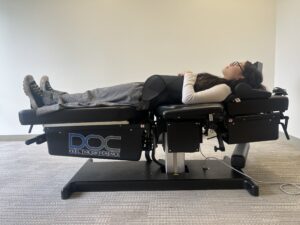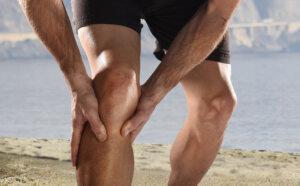A back strain or sprain is when the muscle tendon or ligament goes beyond its stretch capacity where the muscle fibers get sometimes a little bit shredded or there are micro tears. Now I like to compare that to a rubber band. If we stretch a rubber band to its normal limit, it’s going to bounce right back. If we stretch the rubber band beyond its limit, then it may not take its normal shape or form and it may be too loose and vulnerable. And so that’s exactly what’s happening to the muscles, tendons, and ligaments.
To be precise, muscles are the belly of the muscle fiber, while the tendons will connect the muscle to the bone, and the ligaments will hold the different bony structures together. So all these structures are what make up parts of the back and there are hundreds of them and each one is vulnerable to a strain or sprain.
What does pain from back strain or sprain feel like?
So a back strain or sprain may feel like a muscle pull, a stiffness, or a tenderness. Sometimes it can get to a point where it completely puts you out, meaning that you might be on the ground unable to move. Because we have multiple spasms in the back. When that happens, there are very specific exercises and stretches that we can chat about and have notes about on our website.
But if it gets to a point where the pain is unbearable, we definitely recommend seeking out medical attention, whether it’s with your primary care or your chiropractor, or even an Acupuncturist.
if it feels more like a tenderness. Sometimes if you go in and you get checked by palpating or pushing on the bony parts or the muscle parts, it feels tender. Well, that could also indicate having a sprain or strength. And that’s important to differentially diagnose for any sort of more disc pain or more a structural deeper pain.
Sometimes back sprain or strain can actually affect the quality of life. It can limit how far you can walk. It can limit what home chores you might be able to do. And at that point, it’s important to take a pause, possibly get officially diagnosed, and get to a place where you can do some stretches and exercises to help alleviate the pain. Other things that can really help alleviate pain are Icing and resting.
More reading we think you’ll like:
What is the main cause of back strain or sprain?
There’s definitely a multitude of causes. Sometimes a cause of a back sprain or strain could be overactivity. So doing a sport that could be more of a high impact sport such as running, jumping, box jumps, or jump rope, sometimes it can be doing a repetitive activity using your back multiple times in a row with forward folds or forward bends can cause a back sprain or strain.
There are definitely certain risk factors that may also cause back strains that could be a weight issue. The simple truth is that carrying extra weight impacts the body. That can make you more likely to have back strain. Also twisting and quick motions can cause that, especially if the muscle is not warmed up yet. A lot of back sprains and strains tend to happen more in the mornings versus the evenings because the muscles haven’t had a chance to warm up or get more active.
What are the symptoms of a back sprain or strain?
Some of the symptoms could be a tenderness to touch at the structure of the back. Sometimes it can be more of an acute pain where it feels almost like a spasm. Sometimes when we’re having spasms it’s even hard to move. So, having rest and being still would be the best way to give relief to your back. The best way to rest your strained back is going to be on your back with your knees bent.
Sometimes it can cause an inability to move in a normal posture. So if you’re walking or standing you might be in a little bit more of a hunched-over forward position because of the spasm from the strain. Sometimes back sprains and strains can be worse to the point where you may feel it in the buttocks, the hamstrings, and even the legs. At that point, it’s important to go seek a professional to make sure that it is purely muscular and there’s no nerve involvement.
Sometimes back sprain and strain can last 10 to 14 days. A lot of back strains may even resolve on their own. But if it doesn’t, and it lasts beyond that 14 days, it’s important again to seek some sort of professional guidance.
To get to the root cause of pain and discomfort, schedule an initial consultation, including a comprehensive evaluation and first treatment.
How is a back sprain or strain diagnosed?
It’s important to look at not only the clinical aspect of it and the history of how the injury occurred, but also possibly some sort of imaging. With the clinical history, it’s usually from quick motions or repetitive tasks, so it’s important to get a thorough history of the injury. But if it gets to a point where the pain is unbearable and it’s harder to diagnose based purely on the clinical history, it’s important to get some imaging through an MRI most likely. An X-ray is going to look at strictly the bone structures, while the MRI is going to be looking at the muscular structures, the tendons, and the ligaments. And so that might be the best way to diagnose your back sprain or strain.
How does back strain affect the body?
A lot of times, back strain can affect the body in a way to create inflammation within the body and that can lead to pain. And of course, with pain, we have definitely some tools in our toolbox to help alleviate some of that pain. Most people tend to go with anti-inflammatories, Icing, and rest to resolve their back pain. A lot of back pain does self-resolve, but there are a few instances where it can last for quite some time.
Can back strain or sprain be cured?
Yes, of course. Yes, for the most part, back strain or sprain can be cured. As I mentioned, a lot of its self-resolving. But if it’s not, then it’s important to get again the cocktail of medications, meaning pain relievers, anti-inflammatories, resting and Icing, 10-15 minutes every hour as needed at the area of pain.
If it does not resolve in the first couple of weeks, it’s important to seek out professional guidance. If it’s something a little bit more intense, it may require some treatment. And that’s where Chiropractic and Acupuncture care can really benefit in shortening that recovery period.
Who is more prone to Back Strain & Back Sprain?
Back strain and sprain are partly age-dependent. When we’re at a younger age, a lot of the back strain can self-resolve and get better a lot quicker with the shorter recovery time. When we’re over the age of 60, it may require more time, even up to a couple of months for it to completely resolve with the guidance of a professional healthcare provider that can help with therapy while you’re doing self-therapy or self-medication at home as well.
What are the best treatments to manage your back sprain or strain?
So to manage your back pain, there’s definitely a happy medium between being active and resting. A little bit of too much of either one can cause your back pain to get worse. It’s important not to be completely sedentary because that can dehydrate the muscles and tighten up the muscles. So it’s important to get a little bit of activity in during the day. Now, that doesn’t mean high-intensity activities, it usually means light walking, and light stretching. This can help to alleviate your back pain as well as have adequate rest in between. The best way to get your rest is going to be usually on a sturdier surface, maybe on the ground with your knees bent to help flatten out the back and take pressure off your back.
Physical therapy
A doctor or a chiropractor may also recommend physical therapy or rehab exercises to help reduce your back pain.
And sometimes that is with a physical therapist and sometimes that may be just rehab exercises at home. Light stretches and non-high-impact sorts of exercises can help to reduce pain and inflammation at those specific structures. A physical therapist may recommend more regular exercise, mostly on a daily basis with some rest days built into it.
Alternative treatment
For the best treatment of your back pain, your doctor may recommend, Icing, heating, ultrasound, shockwave, and laser therapy as other alternatives to help aid in the recovery of your back pain. In addition to that, here at Truspine, we offer great services at our clinic in San Francisco such as chiropractic care, and acupuncture care, and we have great referrals for massage therapy as needed.
Home remedies for back strain or sprain
Things that you can do at home on your own, in addition, could be again taking pain medication, anti-inflammatories, muscle relaxers, and basically kind of the do-it-yourself exercises at home.
What are the best coping mechanisms for your back strain or sprain?
Now with coping mechanisms, there’s a multitude of options. What we want to be doing is definitely core strengthening. That’s going to be the most important thing to help prevent your back strain from getting worse or coming back. Now there are definitely some do’s and don’ts in terms of what you should be doing while going through back strain or sprain at home.
Do’s and Don’ts while coping with your back strain and sprain
That’s going to be limiting your sitting, especially on the couch, as well as driving for long distances. This can round your back and over-stretch the muscle fibers in the lower back, making your back vulnerable, and causing inflammation. So you definitely want to limit your sitting. You want to vary between sitting and standing as much as possible. You want to go on light walks if you can, to create movement in the back. Also, you want to make sure you practice correct posture, which means standing or lifting posture.
So you want to make sure that you’re using more of the lower extremities or your hips when you’re bending to pick something up. Whether it’s light or heavy, you want to make sure that you’re not bending at the low back and bending more at the waist. So having correct posture while you’re standing and sitting and lifting are very, very important.
Best sleeping position for back strain and sprain
Sleep ergonomics is just as important if you’re a back or a side sleeper. It’s important to have possibly a pillow underneath the knees as a back sleeper. Pillow between the knees for side sleeping which can help keep the pelvis in neutral, so that way you’re not waking up with back pain and setting yourself up to feel pretty good for the rest of your day.
Stretching your body
Sometimes it’s nice to do stretches before you go to bed or even first thing in the morning, and you can even do both. I think it’s important to keep it loose before and after sleeping. Sleeping is a catatonic state which keeps the muscles stuck in one position, sometimes dehydrating the muscles because we’re not drinking enough fluids at night. It is important to do those stretches before going to bed as well as the first thing when waking up as prescribed by your primary care.
Hydrate body
Of course, during the day, it is important to drink enough water to keep the muscles hydrated. The general rule for drinking water is going to be half your body weight in ounces and that seems to be a pretty good thing to do to keep those muscles hydrated and flowing well.
Quit smoking
Well, another important piece is quitting smoking. It seems kind of out there, it seems kind of random. But smoking is a big risk factor for atherosclerosis, which can also cause calcification in the arteries and can cause you to have back pain. So reducing smoking can help with that, but also just decreasing inflammation in the body as well. So that’s an important piece.
Avoid stress
Also avoiding stressful situations for your back, which could be mental stress or physical stress. If you have a big deadline at work, that can cause mental stress, which can cause you to change your posture, causing more stress on your back. It’s important to take micro-breaks, especially if you’re going through an 8,10, or 12 hours/work day. Take those breaks to either lie down decompress or get a glass of water or even just close your eyes and meditate. So those are the coping mechanisms to help with your back strain or sprain.
Conclusion:
When you are suffering from a back strain or sprain, you may find it very difficult to sit in one position for a long time. It can also put your active lifestyle to a halt.
Are you feeling back pain? Well, that could be a back strain or sprain. If you have any questions, please don’t hesitate to get your first phone consultation with us or even an in-person consultation where we can take a look specifically at what you might have.
Whether it’s a back sprain or strain or whether it is nerve related or joint-related. We have the experts to help you figure out and diagnose your back pain.
You can schedule an appointment with our San Francisco chiropractor to get correctly diagnosed. Your first treatment is included.



